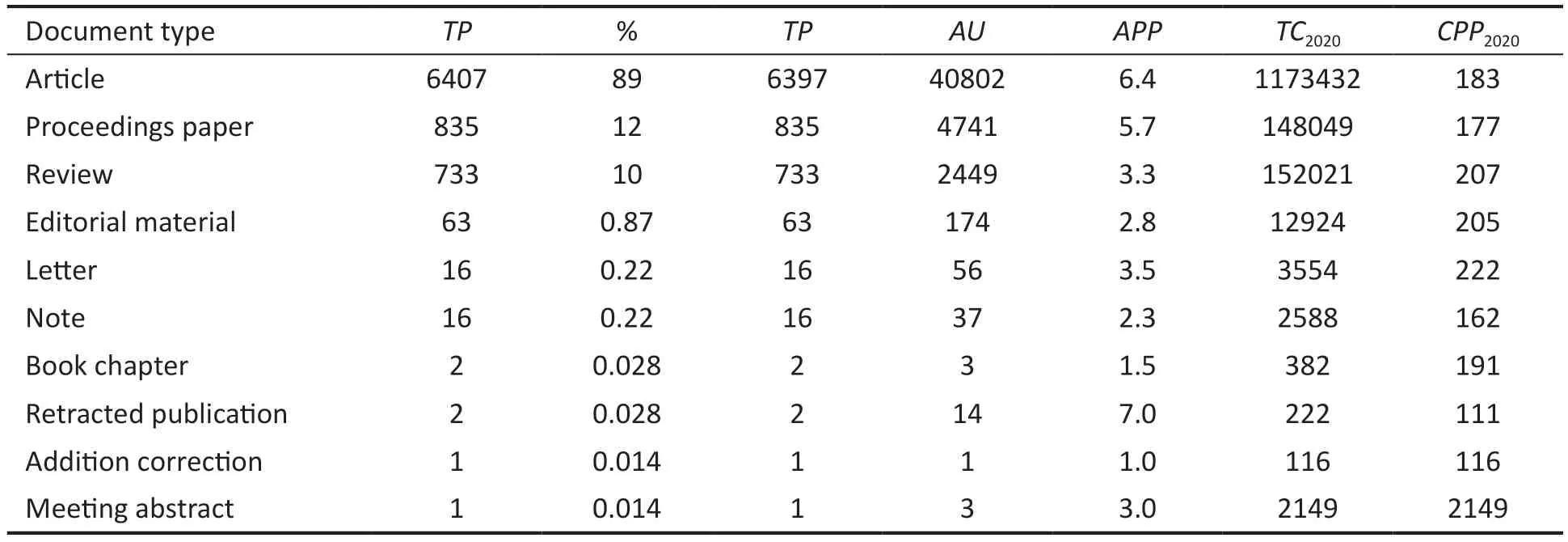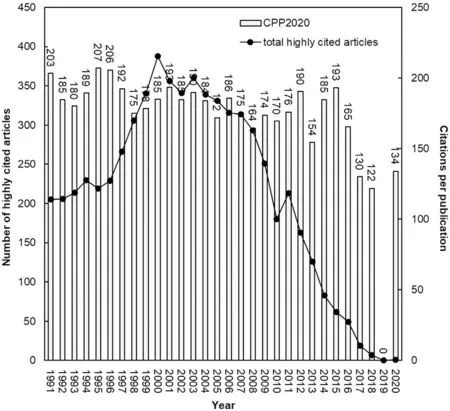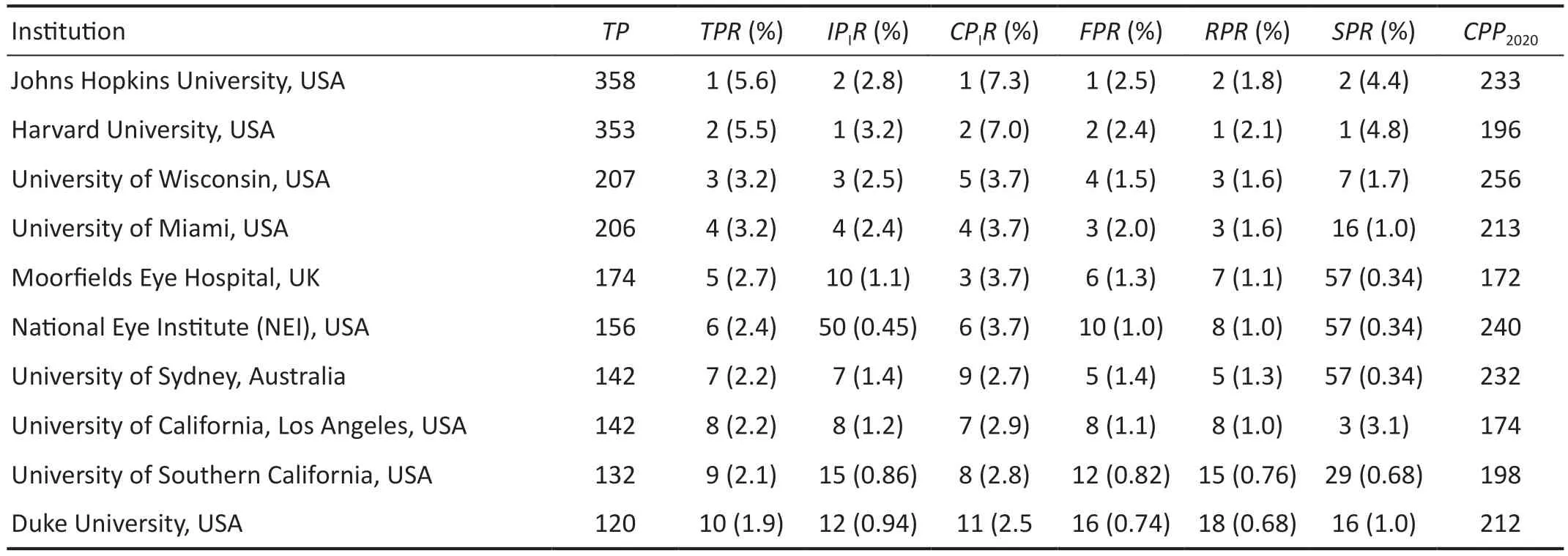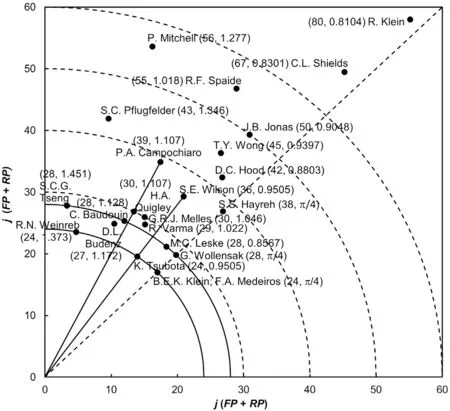Highly cited publication performance in the ophthalmology category in the Web of Science database:a bibliometric analysis
Yuh-Shan Ho, Ali Ouchi, Leila Nemati-Anaraki
1Trend Research Centre, Asia University, Taichung 41354,Taiwan, China
2Student Research Committee, School of Health Management and Information Sciences Branch, Iran University of Medical Sciences, Tehran 1449614535, Iran
3Department of Medical Library and Information Sciences,School of Paramedicine, Hamadan University of Medical Sciences, Hamadan 1452368946, Iran
4Health Management and Economics Research Center, Health Management Research Institute, Iran University of Medical Sciences, Tehran 1449614535, Iran
5Department of Medical Library and Information Science,School of Health Management and Medical Information Sciences, Iran University of Medical Sciences, Tehran 1449614535, Iran
Abstract● AlM: To determine and evaluate the features of highly cited articles (HCAs) in the ophthalmology category in the Science Citation Index Expanded (SCI-EXPANDED) from 1991 to 2020.
● KEYWORDS: ophthalmology; bibliometric analysis;TCyear; Cyear; CPPyear; highly cited articles
INTRODUCTION
Ophthalmology research demonstrates the quality and excellence of medical education, clinical practice,awareness of ocular and vision problems, and general health standards[1].Objective information about the status quo of ophthalmology research is essential to infrastructure development for understanding, treating, and preventing ocular diseases[2].Due to advances in technology, innovation, and modern science, ophthalmology has become a fast-growing clinical branch of medicine[3].According to a recent study by the World Health Organization (WHO), at least 2.2 billion people suffer from near or distance vision impairment.In at least 1 billion-or almost half-of these cases, visual impairment may have been avoided by adopting appropriate measures.According to estimates of regional disparities, Distance vision impairment is four times more common in low- and middleincome nations than in high-income ones[4].
As we are currently in the era of Big Data, information related to ophthalmology is considerably growing as well.Analysis of these data yields an opportunity to gain awareness and understanding of the development of ophthalmology worldwide.As such, the outputs of vision and ophthalmology research must be properly assessed.Among the different methods available for assessing scientific products,bibliometric studies have proved useful for evaluating the social and scientific significance of a discipline at specific times[5-6].Bibliometrics involves statistical analysis to estimate the quality and characteristics of published works.This unique tool can measure the scientific value of papers and delineate the status quo and hot topics of a domain[7-9].In healthcare and medical sciences, bibliometrics can be used for resource allocation and health policy-making[10].Recently, bibliographic indicators of total citations have been extensively adopted to evaluate classic papers[11]and highly cited articles (HCAs)[12-13].In other words, the impact of a study in a particular research field can be quantified by using the number of citations received by the article, and citation ranking lists can be drawn up to assess the scientific impact and quality of these articles[14-15],By preparing such lists, the most influential articles in a certain discipline or subject and their impact on clinical performance can be identified[15].According to Garfield[13], papers with equal to or more than 100 citations are usually classified under general or clinical medical journals.
Accordingly, HCAs have the greatest impact in a certain context and provide a foundation for a new category[7].These articles'research directions depict the trends in that research area[16].The more citations authors receive, the more influential they are in their domain of expertise[17].A 2003 Japanese study,one of the first to use bibliometric concepts in ophthalmology,examined the 15y from 1988 to 2002.According to this publication, 49.5%, 31.3%, 15.1%, 2.2%, 0.85%, 0.53%, and 0.47% of ophthalmology studies originate from North America,Western Europe, Asia, the Middle East, South America,Eastern Europe, and Africa, respectively[18].Based on the results, 22 T100-Eye papers were published inOphthalmology,17 inInvestigative Ophthalmology and Visual Science, and 16 in theAmerican Journal of Ophthalmology, constituting 55%of all T100-Eye articles.A total of 12 reviews and 88 original research articles were included in T100-Eye, compared to 16 reviews and 84 original research articles in T100-General.In T100-Eye, myopia (16 cases) and age-related macular degeneration (15 cases) were the most frequently examined disease categories, whereas in T100-General, diabetic retinopathy (24 cases) and glaucoma (16 cases) were the most reviewed categories.The two countries that contributed highly to the T100-General (n=36,n=26) and T100-Eye (n=42,n=17)articles were Japan and Singapore, respectively[19].
In the current study, the researchers extracted data from Google Scholar, Scopus, PubMed, Web of Science (WOS),and other databases for bibliographic analysis.WOS was chosen in compliance with recent studies in different fields[20-30].At present, there are over 500 000 documents in the ophthalmology category of the WOS citation database.However, due to the great number of studies, it is difficult to identify major articles.As such, reviewing the published literature in this domain is essential to the identification of HCAs.The findings of this study can be beneficial to ophthalmology policy-makers to decrease public health concerns and health systems' economic burdens globally.More, investigating high-impact and HCAs directs researchers to the diverse areas of each specialty that require further research.Besides, scientific articles' post-publication impact supports researchers and clinicians in finding pathological mechanisms and proposing new preventive and therapeutic strategies accordingly.
The current study aimed to identify HCAs in ophthalmology from 1991 to 2020 and analyze their characteristics,e.g.,authors, countries, institutions, and journals.The authors of ophthalmology HCA were also assessed according to their writing traitsviatheY-index.This research presents the first comprehensive bibliometric analysis of high-quality ophthalmology articles.
MATERIALS AND METHODS
Ethical ApprovalThis study was ethically approved by the Ethics Committee of Hamadan University of Medical Sciences(IR.UMSHA.REC.1401.1032).
The Science Citation Index Expanded (SCI-EXPANDED)in the Clarivate WOS Core Collection provided the pertinent data.A number of 9531 journals were indexed with citation references across 178 WOS categories in SCI-EXPANDED,according to the 2020 Journal Citation Reports (JCR).The WOS ophthalmology category had 62 journals.According to SCI-EXPANDED, 411 315 documents, including 197 572 articles, were retrieved between 1991 and 2020 (updated on 4 December 2021).
Three citation indicators were employed by Ho's group to characterize articles with a high quantity of citations:
TCyear: Quantity of citations to WOS Core Collection since the paper was published until the end of the most recent year[31-32];TC2020shows the total times the study has been cited since it was published until the end of 2020.
Cyear: Quantity of citations in the most recent year[33-34]; TC2020is the number of citations in 2020.
CPPyear: Average number of citations per publication(CPPyear=TCyear/TP)[34-35];TPrefers to the total number of publications.
ATCyearof ≥100 was employed for retrieving HCA[34].Documents with aTC2020≥100 were selected as HCAs in this study.The SCI-EXPANDED document material was reviewed,imported into Microsoft Excel 365, and supplementary coding was performed manually for all the analyses[36-37].
The productivity of nations and institutes in terms of publications was assessed using six publication metrics[34,38]:TP: total number of publications,IP: number of singleinstitution publications (IPI) or single-country authored publications (IPC),CP: number of inter-institutionally collaborative publications (CPI) or internationally collaborative publications (CPC),FP: number of first-author publications,RP: number of corresponding-author publications,SP: number of single-author publications.
SCI-EXPANDED has been first established for researchers to discover the studies; hence, data pre-treatment is usually required when utilizing the data for bibliometric research[39].The corresponding author is listed as the reprint author in the SCI-EXPANDED database; nevertheless, we used the label corresponding author[33].When authorship is left unexplained in a single-author article, that researcher serves as both the corresponding and the first author[34].Similarly, the institution is designated as the first-author and correspondingauthor institution in a single-institutional paper[34].The United Kingdom (UK) has been categorized as the country in which affiliations in Wales, North Ireland (Northern Ireland), Scotland, and England were classed[40].Before 1997, affiliations in Hong Kong were categorized as being in China[41].By checking these, cities in Czechoslovakia redefined affiliations as being in the Czech Republic[42].Affiliations in the West Indies Associated States were examined by their city and categorized as belonging to Barbados.
The performance of the authors in terms of publications was assessed using theY-index.A formula for theY-index is as[33,36]Y-index (j,h), wherejis a constant linked to publishing potential and represents the sum of corresponding-author publications (RP) and first-author publications (FP), andhis a constant related to publication characteristics and represents the polar angle around the ratio ofRPtoFP.The higher thejvalue, the greater the corresponding author and first author contribute to the papers.
jrepresents the total quantity of corresponding-author publications and first-author publications, whileh=π/2 is an author who has only published those papers; π/2>h>π/4 demonstrates that an author has more corresponding-author papers than first-author ones (FP>0);h=π/4 shows that a researcher possesses the same quantity of correspondingauthor publications and first-author publications; π/4>h>0 demonstrates an author who has more first-author articles compared to corresponding-author ones (RP>0);h=0 displays that an author has only published first-author papers, andjdenotes the quantity of these types of publications.
RESULTS
Publication Language and Type of DocumentsWithin the 10 document categories indexed in the WOS, 7237 HCAs(1.8% of 411 315 documents on ophthalmology) with aTC2020of under 100 from 1991 to 2020 were identified.Table 1 lists the characteristics of the 10 document types, such as 6047 HCA with anAPPof 6.4, accounting for 89% of the total 7237 papers.The one highly cited meeting abstract, “What's new in Psychtoolbox-3”which had the highestCPP2020of 2149, is what may be ascribed to meeting abstracts.Moreover,54 journals produced a total of 733 reviews, the majority of which were found in theSurvey of Ophthalmology(182 reviews or 25% of the total number of reviews) andProgress in Retinal and Eye Research(147; 20%).Reviews and articles received around 207 and 183 average number of citations per publication (CPP2020), respectively.“Standardization of uveitis nomenclature for reporting clinical data.Results of the First International Workshop”[41], only one piece of classic editorial material, had aTC2020of 2112.Note that the WOS distinguishes two types of documents.For instance, the document categories of articles and proceedings papers each had 835 highly cited documents.As a result, the overall proportion of document categories in Table 1 is greater than 100%.
For the next analysis, only publications that included an introduction, methods, results, discussion, and conclusion were utilized.Only six of the 6407 HCAs we found in the ophthalmology category (3.2% of the 197 572 articles) were written in non-English languages, including five in German and one in French.
Publication DistributionA total of 6407 ophthalmologyrelated HCAs were examined, covering the years 1991 to 2020.Ophthalmology HCAs in the WOS category fluctuated with an abrupt reduction in the last 20y.The maximum value ofTC2020was 3860, and the average was 183.The distribution of the 6407 articles over the years and theirCPP2020is displayed in Figure 1.No highly cited article was found in 2019, but there was one published in 2020 titled “Stepping up infection control measures in ophthalmology during the novel coronavirus outbreak: an experience from Hong Kong”[43].A significant increase between 1995 (219 articles) and 2000 (388 articles) is reported, which peaked in 2000 and then declined to zero in 2019.
JournalsIn 2020, 62 journals were included in the WOS category of ophthalmology.The 6407 HCAs were published in 54 of these journals (87% of 62 journals), as well as 17 additional ophthalmology journals, such as theArchives of Ophthalmology, which had an IF2014of 4.399 and was no longer included in the ophthalmology category in WOS as of 2020.The top 10 productive journals are listed in Table 2 withAPPandCPP2020.TheInvestigative Ophthalmology &Visual Science,with an IF2020of 4.799 (ranking 8thout of 62 ophthalmology journals) published the most HCAs (1331 articles; 21% of 6407 HCAs), followed byOphthalmology(IF2020=12.079; ranking 2nd) with 1271.A comparison of the journals in Table 2 revealed that articles published in theArchives of Ophthalmologyhad the highestCPP2020of 231 andAPPof 13.

Table 1 Citations and authors according to the document type

Figure 1 Quantity of highly cited articles and average number of citations per publication by year.
Countries, Institutions, and AuthorsA total of 6380 HCA from 78 countries (99.6% of the 6.407 HCAs) had author affiliation data in SCI-EXPANDED.Among the 6380 HCAs,4978 (78%) were single-country articles from 43 nations,while 1402 (22%) were cooperative articles from 78 countries.The top 10 productive nations were compared using the six publication indicatorsTP,IPC,CPC,RP,FP, andSPas well as the average number of citations per publication (CPP2020)[44](Table 3).The top 10 publications were from five European nations, two American nations, two Asian nations, and one Oceanic nation.With 16 HCAs, South Africa was rated #1 in Africa.USA dominated in terms of 6 publication indicators(64% of 293 single-author articles), withTPequal to 3887 HCAs (61% of the 6380 HCA),IPCof 2900 articles (58% of the 4,978 single-country articles), theCPCof 987 articles (70%of the 1402 internationally collaborative papers), theFPof 3469 articles (54% of the 6380 first-author papers), theRPof 3044 articles (53% of the 5752 corresponding-author papers),and theSPof 187 articles.
Furthermore, 2434 of the 6380 HCAs were cited by a single university, constituting 38% of the total, while 3946 of them(62% of the total) were written in collaboration with other institutions.The top 10 prolific institutions were also compared using six publication indicators:TP,IPI,CPI,RP,FP, andSPas well as the average number of citation indicators (CPP2020)[45](Table 4).There were eight institutions in the USA and one each in the UK and Australia.With aTPof 358 HCA (5.6%of the 6380 HCA), aCPIof 290 articles (7.3% of the 3946 inter-institutionally collaborative publications), and anFPof 158 articles, Johns Hopkins University (USA) led the three publication indicators (2.5% of 6380 first-author articles).With anIPIof 78 papers (3.2% of 2434 single-institute publications),theRPof 123 articles (2.1% of 5752 corresponding-author papers), and anSPof 14 articles, Harvard University (USA)came out on top in all three publication indicators (4.8% of 293 single-author articles).A lowestCPP2020of 172 was recorded by Moorfields Eye Hospital (UK), while a highestCPP2020of 256 was recorded by the University of Wisconsin (USA).
A total of 5755 papers (90% of the 6407 HCA) with both corresponding-author and first-author data in the SCIEXPANDED database were used to determine theY-index for highly cited authors.A number of 18 043 authors submitted a total of 5755 articles.In sum, 13 750 authors (76% of the 18 043 authors) possessed no first-author papers; moreover,corresponding-author ones with aY-index=(0, 0); 1299 authors (7.2%) possessed only first-author papers withh=0 andj≠0.A total of 379 authors (2.1%) possessed many firstauthor papers with 0<h<π/4.A total of 1875 (10%) authors possessed a similar quantity of first-author and correspondingauthor papers withh= π/4.Moreover, 159 (0.88%) authors had numerous corresponding-author papers with a π/2>h>π/4,and 581 (3.2%) authors possessed only corresponding-author papers withh=π/2 andj≠0.The distribution of theY-index (j,h) for the top 23 authors with aj≥24 is shown in Figure 2.Each dot stands for one value, which may be one author or many[46],as in the case of B.E.K.Klein and F.A.Medeiros, who both had the sameY-index of 24, π/4.With ajof 80 and 117 HCAs published, comprising 39 first-author and 41 correspondingauthor publications, R.Klein of the University of Wisconsin(USA) had the greatest potential for production.With 32 firstauthor and 35 corresponding-author papers and aY-index of 1, C.L.Shields came in second after Klein (67, 0.8301).In the orthopedics WOS category, Klein also published the majority of first-author and corresponding-author HCAs.Largest number of corresponding-author (RP) and first-author (FP)publications in the ophthalmology category was published by just four of the top 23 highly cited authors (17% of the 23 authors).Compared to the categories of anesthesiology (50%)and emergency medicine (62%)[36], the proportion of authors with similarFPandRPwas lower.The top 52 authors all hadRPs greater thanFP.The values ofj[24]for H.A.Quigley(30, 1.107) and G.R.J.Melles (30, 1.046) were identical.As demonstrated in Figure 2, both the authors are on the same curve (j=30), demonstrating that they have the same potential for publication despite having distinct publishing features.Compared to Melles, with anhof 1.046, Quigley had anhof 1.107 and a higher ratio of corresponding-author to first-author papers.The same publishing potential was shared by S.C.G.Tseng (28, 1.451), C.Baudouin (28, 1.128), M.C.Leske (28,0.8567), and G.Wollensak (28, π/4), all of which hadjvalues of 28.In Figure 2, all these individuals are on the same curve(j=28), indicating that they all have the same potential for publication with distinct publishing features.With anhvalue of 1.451, Tseng had the greatestRPtoFPratio, followed by Baudouin (1.128), Leske (0.8567), and Wollensak (π/4).S.S.Hayreh'sh, G.Wollensak'sh, Klein'sh, and Medeiros'hwere all on a similar straight line (diagonal) and had the same value(π/4).All these authors had the same publication characteristics and a similarRPtoFPratio.With ajof 38, Hayreh had the highest publication potential, followed by Wollensak with ajof 28, Klein and Medeiros with ajof 24, and Wollensak with ajof 24.Similar places on the same straight line were found for S.E.Wilson (36, 0.9505), K.Tsubota (24, 0.9505),P.A.Campochiaro (39, 1.107), and H.A.Quigley (30, 1.107),indicating that Wilson and Tsubota shared the same publishing attributes with anhof 0.9505, and Campochiaro and Quigley shared the same publishing features with anhof 1.107.

Table 2 The 10 most productive journals with highly cited articles in the WOS category of ophthalmology

Table 3 Top 10 most productive countries

Table 4 Top 10 most productive institutions

Figure 2 Top 23 authors’distribution along with their Y-index (j≥24).
DISCUSSION
Ophthalmology is an advanced field whose quality is progressing rapidly.As a useful and objective measure of academic impact, bibliometrics is being used more often in academic advancement procedures.In this research, within 10 document categories listed in the WOS, 7237 HCAs on ophthalmology with aTC2020of under 100 from 1991 to 2020 were identified.The proportion of HCAs varied in the medically related areas of emergency medicine (0.95%)[36], healthcare sciences and services (1.1%)[38], dentistry, oral surgery, and medicine(1.8%)[47], and anesthesiology (3.7%)[48].Although the quantity of HCA and citations of each paper had a decreasing fluctuation annually in this research, the number of ophthalmology papers was less than other papers published globally[3].
Articles (n=6407), proceedings papers (n=835), and reviews(n=733) were respectively the top three types of HCAs in ophthalmology.Reviews and articles both received around 207 and 183 average number of citations per publication (CPP2020),respectively.Highly cited items in the WOS category of emergency medicine also had comparableCPPyearfor reviews and articles[36].Only six of the HCAs were written in languages other than English.Similar numbers of citations were recorded in both reviews and articles.The only piece of classic editorial material was “Results of the First International Workshop”.
There were 6407 HCAs in ophthalmology, the majority of which were published in the 2000s.Moreover, the most average number of citations per publication belonged to articles published in 1995.Unquestionably, more time is needed for the most recent articles to gain citations[49].To measure the impact of publications, at least one decade is said to be required to monitor citation counts[50].The number of citations of a paper has become a valuable indicator for evaluating the efforts made by authors and journals as a measure of the paper`s impact on a particular field[51].Conversely, some studies have remarked that ophthalmology publication has a long history, and after so many years of development, it has reached.
The geographical arena of ophthalmology research is extensive, and the USA is the leading country in this field,followed by the UK and Germany, respectively.Wanget al[51]indicated that the top 100 most cited articles were originated from 14 countries led by the US.Other ophthalmology publications confirm these findings[3,52], while it is contrary to other reports that introduce Italy as having the top 100 cited articles in the field, followed by Germany and the US[53].In some reports, China is the top publishing country (988,27.9%), followed by the US (759, 21.4%) and Japan (303,8.5%).Citations are always used as an important indicator of academic impact.Citation analysis showed that the US had 12 312 citations and ranked first, followed by China (9901 citations) and Japan (6541 citations)[54].
The top 10 publications were from five European nations, two American nations, two Asian nations, and one Oceanic nation.Other reports confirm that China and Japan (Asia) are among the top-producing countries in the field of ophthalmology[52].In this regard, the developmental history of ophthalmology indicates that Asian countries play a crucial role in the world of ophthalmology, but their influence must be increased.Research in ophthalmology is a top priority for US institutions.
Strengthening collaborative research initiatives among diverse countries such as the USA, UK, Germany, and so on is emphasized since collaboration in science and technology that appears in joint activities significantly advances economic globalization[52].Compared to Wanget al[51], in this study, we concluded that ophthalmology research is conducted in highincome countries more than in others.
The majority of important articles were published in the USA;this conclusion is in line with that of other investigations.According to several studies[3,28,39,55-58], the US leads the development of scientific knowledge in medicine, health, and ophthalmology.Our research revealed that China, with 193 articles, had the highestCPP2020, at 210; Canada, on the other hand, had the lowestCPP2020, at 158.The findings of our study differ from those of Kolleet al[59], Schulzet al[60], and others.
In three of the publication indicators, Johns Hopkins University and Harvard University (USA) came out on top, which is contrary to the results reported by some other studies[3,51,53,61].For instance, Wanget al[51]found that the most productive institution with the highest TCs was the National Institutes of Health (NIH) of USA, which has published 12 articles and the TCs reached 3655.
The UK's Moorfields Eye Hospital had the lowest average number of per publication, while the University of Wisconsin(USA) had the highest average number of per publication.According to several studies[28,36,60,62], some of these institutions in the nations seem to be well regarded in other areas.Most significant institutions, authors, and articles on ophthalmology seem to be produced in the US, with or without the cooperation of other nations.Wanget al[61]reported that most productive institutions are from Singapore, but the most prolific and active country is the US.
TheY-index was then employed to compare the research output of various authors.The benefit of theY-index is that when thejof authors is similar,hmay be used to identify their publication characteristics[36].B.E.K.Klein and F.A.Medeiros had the sameY-index.The most likely candidate for publication was R.Klein from the University of Wisconsin (US).In areas relating to medicine, highly cited authors published more correspondingauthor than first-author papers[36,48]and there were different authors responsible for this field all over the world.
Limitations: All the documents in the study were collected from the SCI-EXPANDED, in Clarivate Web of Science.Publications indexed in other databases were not included in the study.The same authors had different initial names and the same institutions had different spellings can be found in SCIEXPANDED.
In conclusion, bibliometrics is a helpful and objective indicator of academic impact and is increasingly being adopted in academic promotion.A total of 7237 highly cited articles in the category of ophthalmology with aTC2020of ≥100 from 1991 to 2020 were found within 10 document types indexed in the WOS.From the HCAs, only six were published in non-English languages.Reviews and articles had similar average number of per publication.“Results of the First International Workshop”was the only classic editorial material.A total of 6407 HCAs belonged to the category of ophthalmology, with most articles appearing in the 2000s.Articles published in 1995 had the highest average number of per publication.A total of 6407 HCAs were published in 54 journals.Investigative Ophthalmology & Visual Sciencepublished the most HCAs.This journal was the most productive journal as reported by Zhanget al[54], but other studies report different journals[61].Most studies were supported by five developed European countries, two by American countries, two by Asian countries,and one by Oceania.The USA ranked top in the six publication indicators, followed by the UK and Germany.Ophthalmology research is a major concern of US institutes.Johns Hopkins University and Harvard University (USA) ranked first in three of the publication indicators.The University of Wisconsin(USA) had the highest average number of citations per publication, while Moorfields Eye Hospital in the UK had the lowest one.B.E.K.Klein and F.A.Medeiros had the sameY-index.R.Klein from the University of Wisconsin (USA) had the highest publication potential.
To the best of our knowledge, this is the first comprehensive bibliometric study to identify HCAs in the last decades using different indicators such as theY-index.This study provides insights into the ophthalmology research conducted in the last decades, supports the identification of the quality of ophthalmology research, discoveries, and trends, and guides future research.
ACKNOWLEDGEMENTS
Conflicts of Interest:Ho YS,None;Ouchi A,None;Nemati-Anaraki L,None.
 International Journal of Ophthalmology2023年7期
International Journal of Ophthalmology2023年7期
- International Journal of Ophthalmology的其它文章
- Chickenpox followed streaky multifocal choroiditis with prednison treatment in a girl with asthma
- Pneumonia and ocular disease as the primary presentations of Takayasu arteritis: a case report
- Unilateral blurred vision in pediatric patient associated with cavum velum interpositum cyst
- Comparison of efficacy of conbercept, aflibercept, and ranibizumab ophthalmic injection in the treatment of macular edema caused by retinal vein occlusion: a Metaanalysis
- Ocular manifestations and quality of life in patients after hematopoietic stem cell transplantation
- Clinical features, radiological imaging, and treatment strategies of nonmetallic intraorbital foreign bodies: a retrospective analysis
